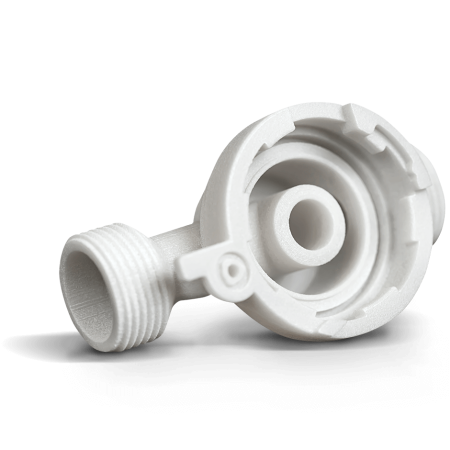Tungsten inert gas (TIG) welding is an arc welding process commonly used for strong, high quality welds of thin sections of metal. Rapid Application Group, a full production additive manufacturing service bureau based in Broken Arrow, Oklahoma, was contracted by a large aerospace company to help optimize and manufacture its TIG welding fixtures, with the specific aim of reducing fixture production time and cost compared to traditional machining. Specializing in mission-critical and time-sensitive support to customers in the oil, gas, motorsports, healthcare and aerospace and defense sectors, Rapid Application Group used 3D Systems’ selective laser sintering (SLS) technology and DuraForm® GF material to help its customer reach this goal.
By using an additive manufacturing workflow, final welding fixture production time was reduced by 84% and fixture cost was reduced by 56%.
3D printing optimized TIG welding fixtures
Additive manufacturing offers several advantages over traditional manufacturing when it comes to fixture production. In addition to speed and cost advantages, 3D printing enables complex shapes to be produced that would otherwise be impossible. Rapid Application Group used this capability to topologically optimize its customer’s TIG welding fixture design and introduce a cascade of positive impacts.
Topological optimization of the welding fixture enabled less material to be used without any adverse effect on part function. Less material usage lowered fixture production cost and print time to achieve both of the customer’s primary goals with a single strategy. The lighter 3D printed welding fixture was also easier to maneuver, which introduced additional functional improvements. The ability to design and manufacture a part with reduced weight and greater or equal strength is a unique capability of 3D printing.
Heat resistant 3D printed nylon
Material properties play a decisive role in determining the suitability of a manufacturing process for any given application. In the case of welding fixtures, key criteria include the ability to withstand high temperatures and remain stable in the presence of pressure, motion or force. For this reason, Rapid Application Group selected DuraForm GF for this application, a glass-filled engineering nylon 12, with excellent stiffness and heat resistance. “It was immediately clear that DuraForm GF was the right material for the job,” says Terry Hill, founder and CEO of Rapid Application Group.
Efficient SLS printing powers true production solution
To accelerate this project further, Rapid Application Group used 3D Systems’ 3D Sprint® software to optimize part nesting within the build platforms of its sPro™ 60 SLS printers and reduced internal project turnaround time to just two days. This was an impressive time savings for the customer, who had been experiencing growing lead times and escalating prices using traditional machining.
3D Sprint is a powerful, all-in-one additive manufacturing software included with 3D Systems’ plastic printers that enables streamlined file optimization, preparation and printing, as well as a suite of advanced features for design, file correction, analysis and more.
According to Hill, combining 3D Systems’ SLS printers, 3D Sprint software and DuraForm material results in a high quality and productive workflow. “3D Systems’ SLS technology is a time-tested, true production additive manufacturing solution,” he says.
Learn more about 3D printing for accurate and functional jig or fixture applications.
